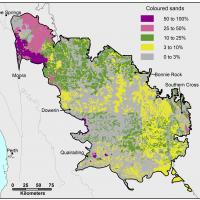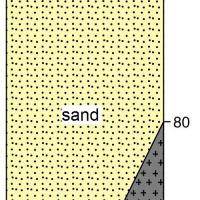Summary
| Occurrence | Central North (8%) |
|---|---|
| Soil Groups of Western Australia (WA) | 441 Brown deep Sand (Alluvial brown sands) 445 Red deep sand 446 Yellow deep sand (Spearwood sands, Karrakatta sands) |
| Also known as | Alluvial brown sands, Spearwood sands, Karrakatta sands |
| Australian soil classifications | (Dominant ASC: Orthic Tenosol) 441- Orthic Tenosol, Aeric Podosol 445 – Red-Orthic Tenosol 446 – Yellow-Orthic Tenosol |
Distinguishing features
Topsoil
- Brown, red or yellow acidic sands.
Subsoil
- Ironstone gravel may be present (445, 446).
- Subsoils sands often acid to neutral pH.
- Limestone or ferricrete may be present >80cm.
Constraints
The following data has been derived from actual site samples taken. These results are recorded in this Excel spreadsheet.
| Rating | Limitation |
|---|---|
| Not applicable (n/a) | No constraints identified |
| Minor | Minor constraint - reduces crop yields in some years |
| Major | Major constraint - reduces crop yields in most years |
| Severe | Severe constraint - will always reduce crop yields |
| Soil Groups of WA | 441 Brown deep sand* | 441 Brown deep sand* | 446 Yellow deep sand* | 446 Yellow deep sand* |
| Constraints | Topsoil | Subsoil | Topsoil | Subsoil |
| Acidity and aluminium toxicity | Minor | Minor | Major | Major |
| Salinity | n/a | n/a | n/a | n/a |
| Sodicity and alkalinity | n/a | n/a | n/a | n/a |
| Boron toxicity | n/a | n/a | n/a | n/a |
| Poor nutrient retention | Minor | Minor | Major | Major |
| Aggregate stability | n/a | n/a | n/a | n/a |
| Compaction and hard layers | n/a | Minor | n/a | Minor |
| Hard setting and crusting | n/a | n/a | n/a | n/a |
| Water repellence | Minor | n/a | Minor | n/a |
| Low plant available water | Minor | Minor | Minor | Minor |
| Water-logging (seasonal) | n/a | n/a | n/a | n/a |
| Wind erosion | Minor | n/a | Minor | n/a |
| Water erosion | n/a | n/a | n/a | n/a |
*Note - Data derived from site identifications (ID's).
Soil Group of WA - 441 Brown deep sand site ID includes: COR 1471, FFS 0066.
Soil Group of WA - 446 Yellow deep sand site ID includes: FFS 0068, TSL 0692, TSL 0349.
Further information
Grealish, G and Wagnon, J (1995) Land Resource of the Bencubbin Area. Land Resource Series No. 12. Agriculture Western Australia.
Lantzke, N and Fulton, I (1993) Land Resource of the Northam Region. Land Resource Series No. 11. Agriculture Western Australia.
McArthur, WM (2004) Reference Soils of South-western Australia (Reprint). Department of Agriculture, Western Australia.
Moore, G (2004) Soil Guide: A Handbook for Understanding and Managing Agricultural Soils. Bulletin 4343. Department of Agriculture, Western Australia.
Sawkins, D (2010) Landscapes and Soils of the Northam District. Bulletin 4803. Department of Agriculture and Food, Western Australia.
Sawkins, D (2009) Landscapes and Soils of the Merredin District. Bulletin 4788. Department of Agriculture and Food, Western Australia.
Schoknecht, N and Pathan, S (2013) Soil Groups of Western Australia. Resource Management Technical Report 380. Department of Agriculture and Food, Western Australia.
Stoneman, TC. (1992) An Introduction to the Soils of the Merredin Advisory District. Bulletin 4235. Department of Agriculture.




